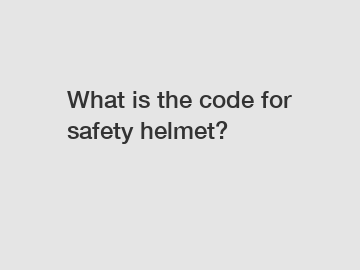Dec. 14, 2023
Shoes & Accessories
Safety helmets are a vital piece of personal protective equipment (PPE) that plays a fundamental role in safeguarding individuals in various industries from potential head injuries. Whether they are worn in construction sites, industrial settings, or even recreational activities such as cycling or skateboarding, safety helmets are designed to provide a crucial layer of protection. In this blog, we delve into the realm of safety helmets, uncovering what their encoded identifiers mean, and how they ensure our well-being in hazardous environments.
Understanding Safety Helmet Codes:
Safety helmets are distinguished by various codes imprinted on their surface, serving multiple purposes like identification, certification, and standardization across different regions and industries. It is important to be familiar with these codes to ensure we are using appropriate helmets that adhere to specific safety regulations.

Before we explore the key aspects of code identification, it is crucial to note that different regions or industries may adopt varying sets of codes. However, we will focus on some common codes typically found on safety helmets worldwide.
1. IEC/EN Codes:
International Electrotechnical Commission (IEC) and European Norm (EN) codes evaluate safety helmets' electrical insulation properties. These codes ensure the helmet is capable of protecting against electrical hazards, such as low-voltage electrical currents. They also signify compliance with specific standards, reinforcing the helmet's quality and reliability.
For instance, IEC EN 397 denotes conformity with the European standard for industrial safety helmets, which include requirements for shock absorption, resistance to penetration, and chin strap functionality.
2. ANSI/ISEA Codes:
The American National Standards Institute (ANSI) and International Safety Equipment Association (ISEA) codes pertain to protective helmets worn in areas where high-impact incidents may occur. ANSI/ISEA Z89.1 is a widely recognized code in North America, promoting safety standards across industries such as construction, mining, and manufacturing.
These codes evaluate various helmet aspects, including shock absorption, weight, penetration resistance, and electrical insulation. By adhering to these codes, helmet manufacturers ensure products are suitable for specific hazardous environments.
3. Color-Coding:
In addition to alphanumeric codes, safety helmets often incorporate color-coding systems to quickly identify workers based on their roles and responsibilities. This further enhances on-site safety by facilitating easy recognition, communication, and coordination among team members.
Color-coding systems may differ based on industry or location. For example, in construction sites, blue might be assigned to supervisors, while red helmets may signify safety inspectors. These codes streamline work processes while promoting efficient communication and organizational structure.
Benefits of Adhering to Safety Helmet Codes:
The presence of well-defined codes on safety helmets provides several significant benefits, ultimately ensuring the safety and well-being of individuals in hazardous environments.
1. Compliance: Safety helmet codes emphasize adherence to certified standards and regulations, prompting manufacturers to produce high-quality, standardized products. Compliance ultimately minimizes the risk of accidents and injuries caused by substandard or ineffective protective gear.
2. Identification: With alphanumeric codes and color-coding systems, safety helmets enable easy identification of individuals based on their roles or expertise. This fosters a more organized and structured work environment, facilitating swift communication and coordination among workers.
3. Communication: Safety helmets with clear codes also enhance communication within teams, as employees can be instantly recognized, reducing potential confusion or miscommunication. Efficient communication is essential for effective emergency response, ensuring the right individuals are alerted promptly.
4. Enhanced Safety Culture: By following codes and adhering to safety regulations, employers and workers actively contribute to the development of a strong safety culture. This promotes a heightened focus on hazard prevention, fostering a safer working environment for everyone involved.
Conclusion:
While safety helmets may appear simple at first glance, they carry vital codes and identifiers that guarantee protection against potential head injuries. These encoded markings demonstrate compliance with regulations, promote communication, and support the cultivation of a robust safety culture.
As we navigate hazardous environments, it is crucial to familiarize ourselves with safety helmet codes and their significance in safeguarding lives. By wearing appropriate helmets and championing safety standards, we contribute to the well-being of ourselves and those around us, ensuring a safer and more secure future for all.
Want more information on food industry footwear, Industrial PVC Work Boots, PVC work safety boots? Feel free to contact us.
If you are interested in sending in a Guest Blogger Submission,welcome to write for us!
All Comments ( 0 )